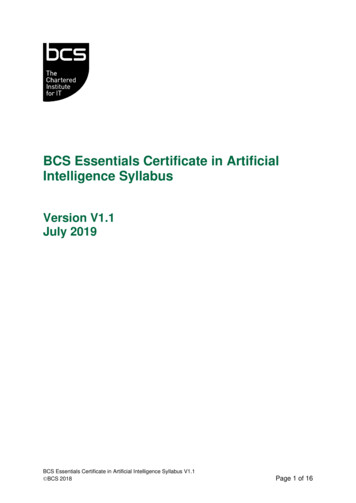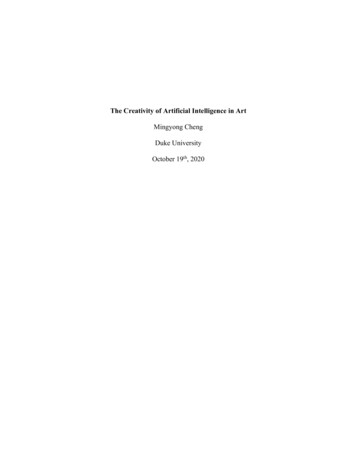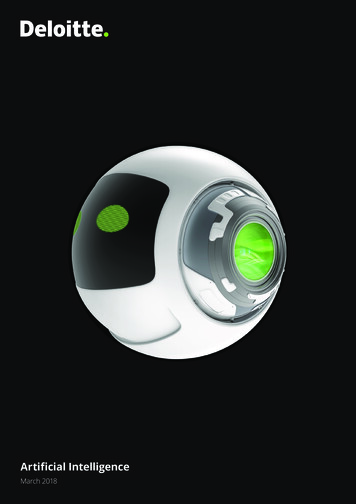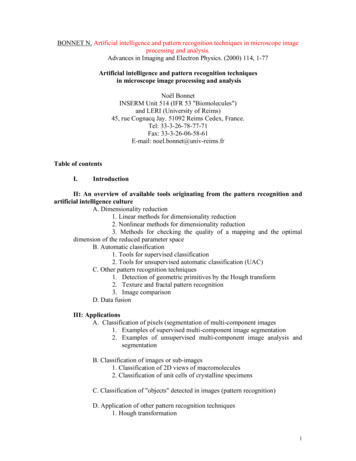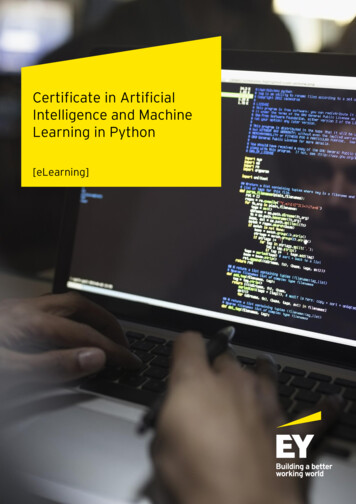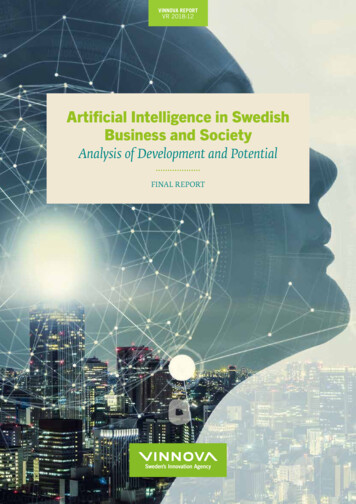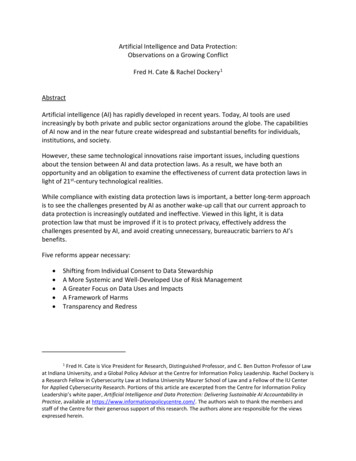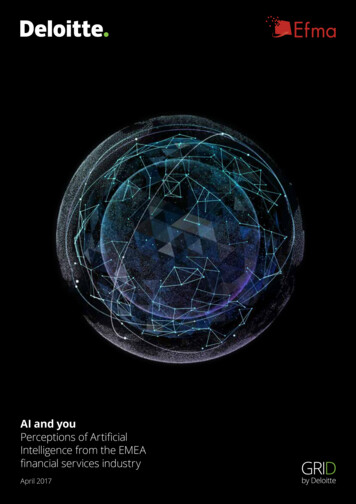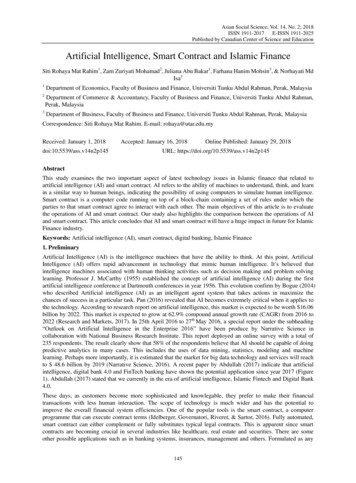
Transcription
Asian Social Science; Vol. 14, No. 2; 2018ISSN 1911-2017E-ISSN 1911-2025Published by Canadian Center of Science and EducationArtificial Intelligence, Smart Contract and Islamic FinanceSiti Rohaya Mat Rahim1, Zam Zuriyati Mohamad2, Juliana Abu Bakar1, Farhana Hanim Mohsin3, & Norhayati MdIsa31Department of Economics, Faculty of Business and Finance, Universiti Tunku Abdul Rahman, Perak, Malaysia2Department of Commerce & Accountancy, Faculty of Business and Finance, Universiti Tunku Abdul Rahman,Perak, Malaysia3Department of Business, Faculty of Business and Finance, Universiti Tunku Abdul Rahman, Perak, MalaysiaCorrespondence: Siti Rohaya Mat Rahim. E-mail: rohaya@utar.edu.myReceived: January 1, 2018doi:10.5539/ass.v14n2p145Accepted: January 16, 2018Online Published: January 29, 2018URL: https://doi.org/10.5539/ass.v14n2p145AbstractThis study examines the two important aspect of latest technology issues in Islamic finance that related toartificial intelligence (AI) and smart contract. AI refers to the ability of machines to understand, think, and learnin a similar way to human beings, indicating the possibility of using computers to simulate human intelligence.Smart contract is a computer code running on top of a block-chain containing a set of rules under which theparties to that smart contract agree to interact with each other. The main objectives of this article is to evaluatethe operations of AI and smart contract. Our study also highlights the comparison between the operations of AIand smart contract. This article concludes that AI and smart contract will have a huge impact in future for IslamicFinance industry.Keywords: Artificial intelligence (AI), smart contract, digital banking, Islamic Finance1. PreliminaryArtificial Intelligence (AI) is the intelligence machines that have the ability to think. At this point, ArtificialIntelligence (AI) offers rapid advancement in technology that mimic human intelligence. It‟s believed thatintelligence machines associated with human thinking activities such as decision making and problem solvinglearning. Professor J. McCarthy (1955) established the concept of artificial intelligence (AI) during the firstartificial intelligence conference at Dartmouth conferences in year 1956. This evolution confirm by Bogue (2014)who described Artificial intelligence (AI) as an intelligent agent system that takes actions in maximize thechances of success in a particular task. Pan (2016) revealed that AI becomes extremely critical when it applies tothe technology. According to research report on artificial intelligence, this market is expected to be worth 16.06billion by 2022. This market is expected to grow at 62.9% compound annual growth rate (CAGR) from 2016 to2022 (Research and Markets, 2017). In 25th April 2016 to 27th May 2016, a special report under the subheading“Outlook on Artificial Intelligence in the Enterprise 2016” have been produce by Narrative Science incollaboration with National Business Research Institute. This report deployed an online survey with a total of235 respondents. The result clearly show that 58% of the respondents believe that AI should be capable of doingpredictive analytics in many cases. This includes the uses of data mining, statistics, modeling and machinelearning. Perhaps more importantly, it is estimated that the market for big data technology and services will reachto 48.6 billion by 2019 (Narrative Science, 2016). A recent paper by Abdullah (2017) indicate that artificialintelligence, digital bank 4.0 and FinTech banking have shown the potential application since year 2017 (Figure1). Abdullah (2017) stated that we currently in the era of artificial intelligence, Islamic Fintech and Digital Bank4.0.These days, as customers become more sophisticated and knowlegable, they prefer to make their financialtransactions with less human interaction. The scope of technology is much wider and has the potential toimprove the overall financial system efficiencies. One of the popular tools is the smart contract, a computerprogramme that can execute contract terms (Idelberger, Governatori, Riveret, & Sartor, 2016). Fully automated,smart contract can either complement or fully substitutes typical legal contracts. This is apparent since smartcontracts are becoming crucial in several industries like healthcare, real estate and securities. There are someother possible applications such as in banking systems, insurances, management and others. Formulated as any145
ass.ccsenet.orgAsian Social ScienceVol. 14, No. 2 2018other technology and innovation driven, the smart contract and artificial intelligence might be adopted in someIslamic banking products. Whilst, Kmeid (2017) found that AI is capable of creating machine learning tools anddeep neutral networks which can bring a whole new experience to the finance industry.Digital Bank 4.0 (2017-onwards)(Fin-Tech banking, artificialintelligence, virtual banks, virtualbranches, inter-cloud interraction)Digital Bank 3.0 (2009-2016)(big data, cloud banking, mobiletransaction, 360 customer)Digital Bank 2.0 (2003-2008)(web based, online payment, KYC,digital channel, data warehouse)Digital Bank 1.0 (1998-2002)(Email, internet banking, database,CRM)Figure 1. Digital Banking EvolutionThis study examines the two important aspects of the latest technology issues in Islamic finance that relates toartificial intelligence (AI) and smart contract. The objectives of this study are three-fold: first, to evaluate theoperational of artificial intelligence (AI) and smart contract, second, to make some comparison on theoperational of artificial intelligence (AI) and smart contract. Third, to elaborate the advantages between the two.This article is organized as follows. A literature review is provided of which is followed by a discussion on theapplication of artificial intelligence and smart contract. Afterwards, the pros and cons of adopting artificialintelligence and smart contract have been review. At last, this research presents the conclusion and somerecommendation.2. Literature ReviewHassabis et al. (2017) study the fields of neuroscience and artificial intelligence (AI). They recognized the needto understand how biological brains works could be the best solution in building intelligent machines. The keyidea is to study the interactions between the AI and neural computation in humans. Hamet and Tremblay (2017)describe the application of AI in medicine. This AI has boosted in genetics and molecular medicine, treatingchronic mental diseases and to update the medical records (family history of a hereditary disease or a chronicdisease). It revealed that AI is rapidly developing in few field like military, security, transport and manufacturing.Khan (2017) identifies that AI is useful for bank and financial institutions through the development called “roboadvisors”. Advancement in “robo advisors” is particularly important because it can act as an automated financialadvisors which helps the user to make their financial decisions (i.e. personal financial management). Sheadmitted in times to come, AI will move towards financial analysis, asset allocation, insurance underwriting,forecasting and reporting due to its unique features related to speed and accuracy.Pan (2016) wrote that several firms that are currently adopting artificial intelligence (AI) in particular projects.However, most of the investments and initiatives were also in its infancy stage. According to Pan (2016)Microsoft developed the chatting robot known as Xiaobing. Meanwhile, IBM developed the Watson system. Thissystem facilitates the screening of the historical records of the cancer patient in many hospitals. Elsewhere, inChina, Baidu continues to focus on developing platforms for smart devices as well as AI into financial servicessectors. Among other things, this paper acknowledged the efforts done by the Chinese Academy of Engineering.The reason for this, Chinese Academy of Engineering turn current systems into intelligent cities, big data,146
ass.ccsenet.orgAsian Social ScienceVol. 14, No. 2 2018manufacturing, innovative design and the digital creative industry. In the end, Pan (2016) has urged closerstrategic collaboration between scientists and think tanks. This collaboration is important to ensure furtherdevelopment of AI technology.Alzaidi and Kazakov (2008) proposed the artificial intelligence approach to improve the tawarruq process basedon the existing system. They suggested that the supply chain should manage the data flow and links it to thevariety of supply chain network participant (e.g. borrowers, banks, suppliers and warehouse). This system allowseach agent in the network to control its own bank account to make money transfers easy and just in one click.Alzaidi and Kazakov (2008) also promoted tawarruq via international brokers and international markets. Thebank adds a profit on the total and then resell the products on their behalf. Then, the bank will contacts thebroker once again to resell the products for the borrowers.Dirican (2015) clarifies that not only artificial intelligence but also considers, semantic studies, robotics andmechatronics developments, big data, data mining, cloud computing and neural networks as the main trends thatleads to future directions of banking and financial services. A research done by Dirican (2015) acknowledgedthat robots use huge amounts of information called big data from many databases or connected to cloudcomputing and are managed by artificial intelligence. The suggestion could be for production lines and thehuman resource agenda.A closer analysis by Giancaspro (2017) postulates that a smart contract might be programmed to purchase aparticular item at a certain price. This contract should include the product warranties. The novel application ofsmart contracts is said to be an important element rather than the vendor being connected to the purchaser‟spersonal and financial information via a trusted intermediary, as the system is commonly connected directly tothe purchaser‟s digital wallet. Giancaspro (2017) even expressed that this smart contract could lead to identifyingparties in the contract, the deadline for reference to the exchange price of stock, the pre-conditions and the logicfor execution of the program as framed by the pre-conditions.Savelyev (2017) paper analyzes the key element between a traditional contract and a smart contract. The authordefines the smart contract as “agreements existing in the form of software code implemented on the Blockchainplatform”. The nature of the smart contract is based on a predetermined set of factors. Mik (2017) discusses theproblems of integrating this smart contract with the real world. This paper proposed some technological andlegal constraints of the smart contract‟s functions. Nevertheless, Mik (2017) demonstrates that smart contract issuitable for banks, lawyers and courts.Szabo (1997) who is the founder of the smart contract, introduced the idea that by utilizing protocols and userinterfaces will facilitate all steps of the contracting process. This smart contract is far more functional than thetraditional contract. According to Szabo (1997) smart contracts will facilitate many financial services, typicallyfor installment loans and credit cards. He believes that smart contracts have the potential to support manyindustry such as banking, insurance, energy, e-government, telecommunication, music and film industry, art,education and many more.3. Application of Artificial IntelligenceFinancial institutions are looking ways to deploy chatbots to handle day-to-day banking tasks in appearance of24/7 customer services activities. In most cases, chatbots offer services for personal financial management (PFM)and wealth management. Chatbots cover several functional areas including:i.Customer Services: Answering simple question from call centres, reporting the lost card and re-setting thePIN number.ii.Product sales: Chatbots helping in identifying or grouping customer according to the banking products.iii.Transaction: Assist in fund transfer between account, paying bills and checking account balance.The simplest chatbot process flow is shown in Figure 2. The main process of chatbot start with the initialpre-processing of the user‟s text. This step require the input text to be converted into speech-to-text (S2T) ortext-to-text (T2S). A step further required the speech-to-text (S2T) or text-to-text (T2S) to be converted intonatural language processor. Natural language processor tasks typically involved the direct hand coding. Theprocess continue to generate a large input data extracted from the users in a structured way.Through machine learning, a bot can review chat histories to augment conversational abilities for financialinstitution and clients. Very simple reply of the conversation will be created to answer the best matches of theuser statement. The post-processing is needed to ensure the chatbot system isn‟t perform badly. The interfaceconnector are supported via Skype, WeChat, WhatsApp, Facebook messenger etc.147
ass.ccsenet.orgAsian Social ScienceVol. 14, No. 2 2018Figure 2. Chatbot process flowThe next three scenario depicts the application of Artificial Intelligence (AI) in banking, which is as follows:Scenario 1Concurrently, the Canada‟s Big Five banks are using AI chat-bots that interact with customers through the bank‟sdigital channels (online, mobile and social media). Based on a pilot project the Royal Bank of Canada has beentesting programmable software bots that can perform administrative tasks such as processing mortgageapplications and insurance claims processes (Ligaya, 2017).As a „living‟ example of how artificial intelligence can be utilized in financial services, Hong Leong Bank‟s A.I.chat service took a first step towards introducing a new channel for customer interaction via live chat function,which is available on the Hong Leong Bank Corporate Website. Figure 3 displays how Hong Leong Bank‟s A.I.chat advisor look‟s like in a real conversation. Hong Leong Bank‟s A.I. chat advisor makes the bankingconversation smarter and more convenient.The A.I. chat advisor is able to answers customer‟s banking questions on topics such as credit cards, fixeddeposit, current and saving account, personal loan, mortgage loan, auto loan etc. This customer chat service aredesigned to carry out pre-scripted conversations. It also has the capabilities to handle any customer inquiry byproviding customer support from start to finish. When necessary, it can even schedule an appointment via thephone according to the customer‟s preferred date and time.Inspired by artificial intelligence technology, RHB bank have introduce personal loan application processingplatform through Chatbot. The chatbot system is the result of a collaboration between RHB bank and financialcomparison website RinggitPlus. Consumers can now apply for their personal loan via Chatbot onRinggitPlus.com and they will obtain the results within a day via SMS. RHB bank is targeting to grow itspersonal loan disbursement by 60% to RM60 million by 2018 via Chatbot. Meanwhile, CIMB bank seek toassist customers in mobile application called CIMB EVA to manage user‟s daily banking needs. To used CIMBEVA customer need to have a valid CIMB Clicks User ID and a mobile device running either iOS 8.1 and aboveor any Android 4.1 and above. With CIMB EVA customer easily check their account balances, paying bills andreload prepaid phones.148
ass.ccsenet.orgAsian Social ScienceVol. 14, No. 2 2018Figure 3. Hong Leong Bank‟s A.I. chat serviceScenario 2“NAO” is a customer service humanoid robot, weighing 5.4 kg and standing 58 cm tall which is currently in its5th version since 2006. It was developed by the French company, recalled as Aldebaran Robotics. This companyis a subsidiary of Japanese telecom and technology giant, SoftBank Corp. Mitsubishi UFJ Financial Group Incwas thought to be the first financial service industry that employed the “NAO” robot (Marous, 2017). Figure 4shown the robot named “NAO” at Mitsubishi UFJ Financial Group Inc in Japan. The “NAO” robot works at thereception area. The main task is to welcome the guests and provides them with information in a variety oflanguages. The “NAO” robots are also able to demonstrate kung fu moves and dance while greeting customersand handing out bankers‟ business cards. The cost is approximately 8,000 and lasts 12 hours between charges.Figure 4. The “NAO” humanoid robot149
ass.ccsenet.orgAsian Social ScienceVol. 14, No. 2 2018Scenario 3Another examples, Mizuho bank use “Pepper” to display the important information about their company. Figure5 clearly show the robot named “Pepper” deploy at the Mizuho Bank in Japan (Softbank Robotics, 2017). It hasan interactive tablet that helps augment communication with users. “Peppers” are connected to the cloud, whichallows them to constantly learn new things. The good news about “Pepper” it can store information whileinteracting with customers on the cloud for future analysis. Pepper stands just 4 feet tall and weight of only 28 kg.Pepper have been installed together with a 3D camera and 10 inch touch screen. Right now, Pepper robot isselling for JPY 198,000 or USD 1,900. With the installation of 3D camera, “Pepper” able to detect customermovement and understand human emotions. “Peppers” respond with simulations of emotions like joy, anger andirritation. It became available to Japanese consumers in June 2015. Since then, approximately 1,000 units ofrobot have gone on sale every month.Figure 5. Robot “Pepper”4. Advantages of Artificial Intelligence (AI)Some of the main advantages of artificial intelligence are listed below:(a) Reducing ErrorAI offers an opportunity to achieve accuracy with a higher degree of precision and this consequently enable tominimize the human errors. Indeed, the cognitive technology error is very rare compared to human errors. In thehealthcare industry, AI have been employed to optimize the clinical procedure. Normally, healthcareprofessionals give prescription based on questioning and routine check-ups. However, in most of the timeshealthcare professional are unable to attend a large number of cases at one time. This might create a chance forerrors. Delegation of duties to AI are meant for medical error that made by human due to excessive workpressure.Jiang, Jiang, Zhi, et al. (2017) believe that AI not only assist physicians to make better clinical decision, it mighteven replace human judgment such as in the radiology area. Another aspect related to the issue, AI reduce errorsin banking services by minimizing the human involvement in cyber, fraud, compliance, credit and internal audit.The data inputs in AI are able to differentiate good transactions from fraudulent ones, which easily beoverlooked by humans. V Maslamani, the Chief Compliance officer of Al Rajhi Bank of Saudi Arabia at theConference on Financial Crime and Terrorism Financing (IFCTF) 2017 admitted that AI will reduce cost andhuman error.Another examples, the recent case of West Wind Aviation Flight 280 on 13 December 2017 inspired thedevelopment of AI technology in the airlines industry. This would allow airlines to use artificial intelligence (AI)autopilot in very complex airline operations. Haitham Baomar and Peter Bentley who led the invention of AIautopilot at University College London intend to reduce the human error factors that might be caused by stress,information overload, lack of sufficient and up-to-date training.(b) Multi-taskingTasks can be classified into routine or non-routine tasks. Repetitive tasks which are monotonous in nature can be150
ass.ccsenet.orgAsian Social ScienceVol. 14, No. 2 2018carried out with the help of machine intelligence. Machines think faster than humans and can be put tomulti-tasking. For example, the same neural network that is designed to filter out spam e-mails may reuse itsknowledge in detecting the phishing attempts, prioritize the inbox in accordance to importance, and assist indrafting the responses to common requests. AI offers keep more information than paper based filing. The hugedataset space to help users to upload multi-task information and find information. In any case, multi-taskingimproves the performance of manufacturing company. Today, AI able to perform various task from forkliftdrivers to product design and quality assurance. With this advanced technology, it is beneficial to themanufacturing industry as it lower the labour cost and reduce dependency on low skilled labour.(c) Work for longer hoursUnlike human, AI are programmed for long hours. AI could change the fast food industry. AI will soon affectevery dining experience including preparing the meal, taking orders and delivery. The innovation in digitalcapability enable the customer to experience a non-stop service from the fast food industry. Other example of AIis the automated teller machine that able to replace the working hours of bank clerk and auto call centers thatable to pick up your call at any time. Undeniable, we are heading to a rapid technology growth and takingadvantages of AI.5. Application of Smart ContractTraditional contract do not occur exclusively via technology. It is relatively straightforward to identify when anoffer has been made and accepted by examining the words and conduct of the parties along with all relevantcircumstances. Alternatively, a smart contract has a potential to become a legal contract if certain conditions aremet. How do smart contract works? The terms of the contracts are coded in computer algorithm as a set ofinstructions that will be automatically execute the next step until the entire transaction cycle completes. Thissmart contract allows immutable, verifiable and secure record of all contracts and transactions which are fullyauditable. It designed in a complex set of software codes with the instruction to automate execution andsettlement of contractual agreement.Figure 6 explains further about the smart contract where the process began once there is agreement betweenparties (i.e. option conract). The data is stored on every computer in the network which is written as code into theblockchain. The smart contract will definitely trigger the important events such as the expiration date and strikeprice. This information is recorded and the smart contract executes itself according to the coded terms. If two ormore parties agreed agreed upon the terms and conditions within the contract, they cryptographically sign thesmart contract and deploy it to a distributed ledger. Later on, once the specific code is met, the programautomatically runs a corresponding action. The final stage are imposed by regulators. Thus, regulators can usethe blockchain in maintaing the privacy of the individual actors‟ position.Figure 7 illustrates the process of smart contract. The pre-defined smart contract sets the specific conditions suchas the rights and obligations to which the parties of a protocol or smart contract consent to. The events trigger theexecution of the contract. This events refer to the transaction initiated and information received. Subsequently,the terms of contract dictate movement of value based on conditions met. As for the settlement, there are twooptions available (i) on-chain assets (digital) and (ii) off-chain assets (physical). For digital assets on the chain,the smart contract opts for crypto-currency (Bitcoin, Ethereum, Lite Coin, Ripple, Dash, NEM, NEO or Monera).As a consequence, payment transactions occur automatically. For physical assets, the smart contract requiresstocks and fiat money. Beyond simple encryption and integrity checks, this system will make changes to specificaccounts reflected on the ledger. The transactions simultaneously updating the match off-chain settlementinstructions.Smart contract could support the Islamic finance products. The terms and legal conditions are specific in legaldocuments and must be executed in the correct order to ensure the compliance to Shariah. In other words, smartcontracts, would streamline the operations of Islamic financial institutions and automate the entire contractualprocess. Smart contracts is expected to support the Islamic banking industry in several areas, alike Islamiccapital markets and investment banking (sukuk, Islamic stock exchange, Islamic wealth management), Islamicbank (trade finance, Islamic REIT‟s, crowd-funding) and takaful industry (automated claims, renewal of generaltakaful products).In fact, Malaysian Digital Economy Corp (MDEC) is looking forward to launched “Islamic Digital EconomyFramework” by March 2018. MDEC is working closely with Jabatan Kemajuan Islam Malaysia (Jakim) andAmanie Advisors Sdn Bhd to formulate the framework. This framework will serves as a guideline for venturecapitals to run a business. Specifically, the paper by Khan (2017) identity the applications of smart contracts withIslamic capital markets, inheritance law and loans. By doing so, smart contracts would bring takaful operators,151
ass.ccsenet.orgAsian Social ScienceVol. 14, No. 2 2018bankers, customers and third parties to a single platform that will lead to process efficiencies, and reduce claimprocessing time and costs.Step 1: Smart contract in written codeStep 2: Program automatically runs a corresponding actionStep 3: Imposed regulators activitiesFigure 6. Scenario of Smart ContractPre-definedcontractExecute & ValueTransferEventFigure 7. Process Flow of Smart Contract152Settlement
ass.ccsenet.orgAsian Social ScienceVol. 14, No. 2 20186. Advantages of Smart ContractThe advantages of smart contract to any other kind of agreement, among others includes:(a) EfficiencySmart contract operate better when there is a rich data set that can be derived from existing information. Eachterm and condition of the contract need to be coded accordingly. The transaction will only be visible to people orparties related to the contract.(b) TransparencyThe transparency will make business-to-business (B2B) transactions easier. This simplifies exchanges andreduces the need for participation from banks, lawyers and middlemen.7. ConclusionThe digital smart contract effectively replace traditional forms of paper contracts. Smart contract helps toimprove to a more credible transaction without jeopardizing authenticity and its credibility. Undoubtedly, digitalsmart contracts have the potential to revolutionize the trade and banking industry. Similarly, the idea of artificialintelligence will not only improve the way we think or live our lives and also to explore new horizons. One canimagine that artificial intelligence and smart contract helps to improve chances of reaching accuracy. At the sametime, it works on minimizing errors in the organization and data management. With banking embracing the newtechnology, bank customers can hope for a better banking experience and fulfilling their rising expectations.ReferencesAbdullah, O. (2017, October 3). Digitalization in Islamic Finance. Retrieved from aidi, A., & Kazakov, D. (2008). Artificial Intelligence for Islamic Banking. Journal of Muamalat and IslamicFinance Research, 5(1), 1-15.Bogue, R. (2014). The Role of Artificial Intelligence in Robotics. Industrial Robot: An International Journal,41(2), 119-123. https://doi.org/10.1108/IR-01-2014-0300Dirican, C. (2015). The Impacts of Robotics, Artificial Intelligence on Business and Economics. Procedia Socialand Behavioral Sciences, 95, 564-573. , K. (2017, December 12). A 50 million Hack just showed that the DAO was all too human. Retrievedfrom -showed-dao-human/.Giancaspro, M. (2017). Is a „smart contract‟ really a smart idea? Insights from a legal perspective. ComputerLaw & Security Review, 33, 825-835. https://doi.org/10.1016/j.clsr.2017.05.007Hamet, P., & Tremblay, J. (2017). Artificial Intelligence in Medicine. Metabolism Clinical and Experimental, 69,36-40. bis, D., Kumaran, D., Summerfield, C., & Botvinick, M. (2017). Neuroscience Inspired ArtificialIntelligence. Neuron, 19(2), 245-258. rger, F., Governatori, G., Riveret, R., & Sartor, G. (2016). Evaluation of Logic-Based Smart Contracts forBlockchain Systems. Rule Technologies. Research, Tools, and Applications,10th International Symposium(pp. 167-183). New York, United States: Springer, Cham. https://doi.org/10.1007/978-3-319-42019-6 11Jiang, F., Jiang, Y., Zhi, H., et al. (2017). Artificial intelligence in healthcare: past, present and future. Stroke andVascular Neurology. http://dx.doi.org/10.1136/svn-2017-000101Khan, N. (2017, December 13). The Impact of Financial Technology. Retrieved from chnology-nida-khanKmeid, R. (2017, December 13). Islamic Banker. Retrieved from Will Artificial Intelligence rejuvenate Islamicfinance? ya, A. (2017, December 23). Financial Post. Retrieved from Rise of the robot: How banks are usingartificial intelligence upfront and behind the scenes. Retrieved from ce-upfront-and-behind-the-scenesMarous, J. (2017, December 22). Robots and AI invade banking. Retrieved from The Financial rtificial-intelligence-ai-banking/153
ass.ccsenet.orgAsian Social ScienceVol. 14, No. 2 2018Mik, E. (2017). Smart Contracts: Terminalogy, technical limitations and real world complexity. Law, Innovationand Technology, 9, 296-300. tive S
Artificial Intelligence (AI) is the intelligence machines that have the ability to think. At this point, Artificial Intelligence (AI) offers rapid advancement in technology that mimic human intelligence. It‟s believed that intelligence machines associated with human thinking activities such as decision making and problem solving learning.
